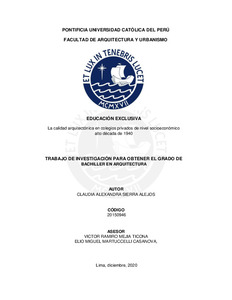| dc.contributor.advisor | Mejía Ticona, Víctor Ramiro | |
| dc.contributor.author | Sierra Alejos, Claudia Alexandra | |
| dc.date.accessioned | 2022-05-18T22:23:49Z | |
| dc.date.available | 2022-05-18T22:23:49Z | |
| dc.date.created | 2020 | |
| dc.date.issued | 2022-05-18 | |
| dc.identifier.uri | http://hdl.handle.net/20.500.12404/22386 | |
| dc.description.abstract | Actualmente existe una brecha amplia en cuanto a infraestructura entre las instituciones
educativas peruanas e internacionales. En el Perú, son las instituciones privadas las que
ayudan a disminuir esta brecha a través de la edificación de espacios adecuados para los
estudiantes. Asimismo, estas son un referente para las escuelas públicas y en la
implementación de una educación de calidad. Como casos de estudio, se toman tres
infraestructuras educativas. El primero es la segunda sede del Colegio San silvestre,
construído en 1943; el segundo, Colegio Pestalozzi, construido desde 1941 hasta 1993, y
la segunda sede del Colegio Franklin Delano Roosevelt, construido en 1948. Para ello, se
abordó bajo 3 parámetros: las relaciones con su contexto urbano próximo, sus conexiones
espaciales que se generan al interior de estas, el espacio funcional y flexible; por último, las
estrategias bioclimáticas activas o pasivas planteadas. En ese sentido, se podrá validar la
calidad arquitectónica en estas instituciones educativas privadas. | es_ES |
| dc.description.abstract | Currently there is a wide gap in terms of infrastructure between Peruvian and international
educational institutions. In Peru, it is private institutions that help reduce this gap through
the construction of adequate spaces for students. Likewise, these are a benchmark for
public schools and in the implementation of quality education. As case studies, three
educational infrastructures are taken. The first is the second headquarters of the Colegio
San Silvestre, built in 1943; the second, Colegio Pestalozzi, built from 1941 to 1993, and the
second headquarters of Colegio Franklin Delano Roosevelt, built in 1948. For this, it was
approached under 3 parameters: the relationships with its immediate urban context, its
spatial connections that are generated by interior of these, the functional and flexible space;
finally, the active or passive bioclimatic strategies proposed. In that sense, the architectural
quality in these private educational institutions can be validated. | es_ES |
| dc.language.iso | spa | es_ES |
| dc.publisher | Pontificia Universidad Católica del Perú | es_ES |
| dc.rights | info:eu-repo/semantics/openAccess | es_ES |
| dc.rights.uri | http://creativecommons.org/licenses/by-nc-nd/2.5/pe/ | * |
| dc.subject | Construcciones escolares--Perú--Lima Metropolitana | es_ES |
| dc.subject | Construcciones escolares--Arquitectura--Perú--Lima Metropolitana | es_ES |
| dc.subject | Arquitectura--Aspectos sociales--Perú--1940-1950 | es_ES |
| dc.title | Educación exclusiva: la calidad arquitectónica en colegios privados de nivel socioeconómico alto década de 1940 | es_ES |
| dc.type | info:eu-repo/semantics/bachelorThesis | es_ES |
| thesis.degree.name | Bachiller en Arquitectura | es_ES |
| thesis.degree.level | Bachillerato | es_ES |
| thesis.degree.grantor | Pontificia Universidad Católica del Perú. Facultad de Arquitectura | es_ES |
| thesis.degree.discipline | Arquitectura | es_ES |
| renati.advisor.dni | 10556604 | |
| renati.advisor.orcid | https://orcid.org/0000-0003-0140-2274 | es_ES |
| renati.author.dni | 75622282 | |
| renati.discipline | 731026 | es_ES |
| renati.level | https://purl.org/pe-repo/renati/level#bachiller | es_ES |
| renati.type | https://purl.org/pe-repo/renati/type#trabajoDeInvestigacion | es_ES |
| dc.publisher.country | PE | es_ES |
| dc.subject.ocde | https://purl.org/pe-repo/ocde/ford#6.04.08 | es_ES |






